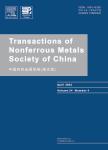Improvement of hydrogen embrittlement and stress corrosion cracking by annealing for Al-4.4Mg-0.6Mn alloy
Improvement of hydrogen embrittlement and stress corrosion cracking by annealing for Al-4.4Mg-0.6Mn alloy作者机构:Division of Marine Engineering Mokpo National Maritime University Media Engineering Seoul National University of Technology
出 版 物:《Transactions of Nonferrous Metals Society of China》 (中国有色金属学报(英文版))
年 卷 期:2011年第21卷第A1期
页 面:17-22页
核心收录:
学科分类:080503[工学-材料加工工程] 08[工学] 0805[工学-材料科学与工程(可授工学、理学学位)] 0802[工学-机械工程] 080201[工学-机械制造及其自动化]
主 题:annealing 5083F A1-Mg alloy corrosion seawater slow strain rate tests
摘 要:With no annealing treatment, cathodic polarization trends in 5083F A1 alloy revealed concentration polarization and activation polarization. However, the annealed specimens have lower current densities at corrosion protection potential compared to the non-annealed specimen. The results of SSRTs conducted in seawater at the applied potential range of-l.8 V to -0.5 V indicated that the maximum tensile strength, elongation, and time-to-fracture had high values at applied potentials of -0.7 to -1.4 V. The maximum tensile strength, elongation, and time-to-f?acture decreased when the potential values were beyond this range in either anodic or cathodic direction. In general, the increased shear lip caused by annealing treatment indicates elongation. Time-to-fracture would likely increase with elongation. Potentials between -0.5 V to -0.6 V were found to be in the region of stress corrosion cracking. The corrosion protection zone was determined to be -0.7 V to -J,4 V because these potential ranges produced good mechanical properties. Potential less than -1.4 V produced a fractured surface with a mixture of dimples (ductile fractures) and a quasi-cleavage pattern resulting from the effects of hydrogen gas.



